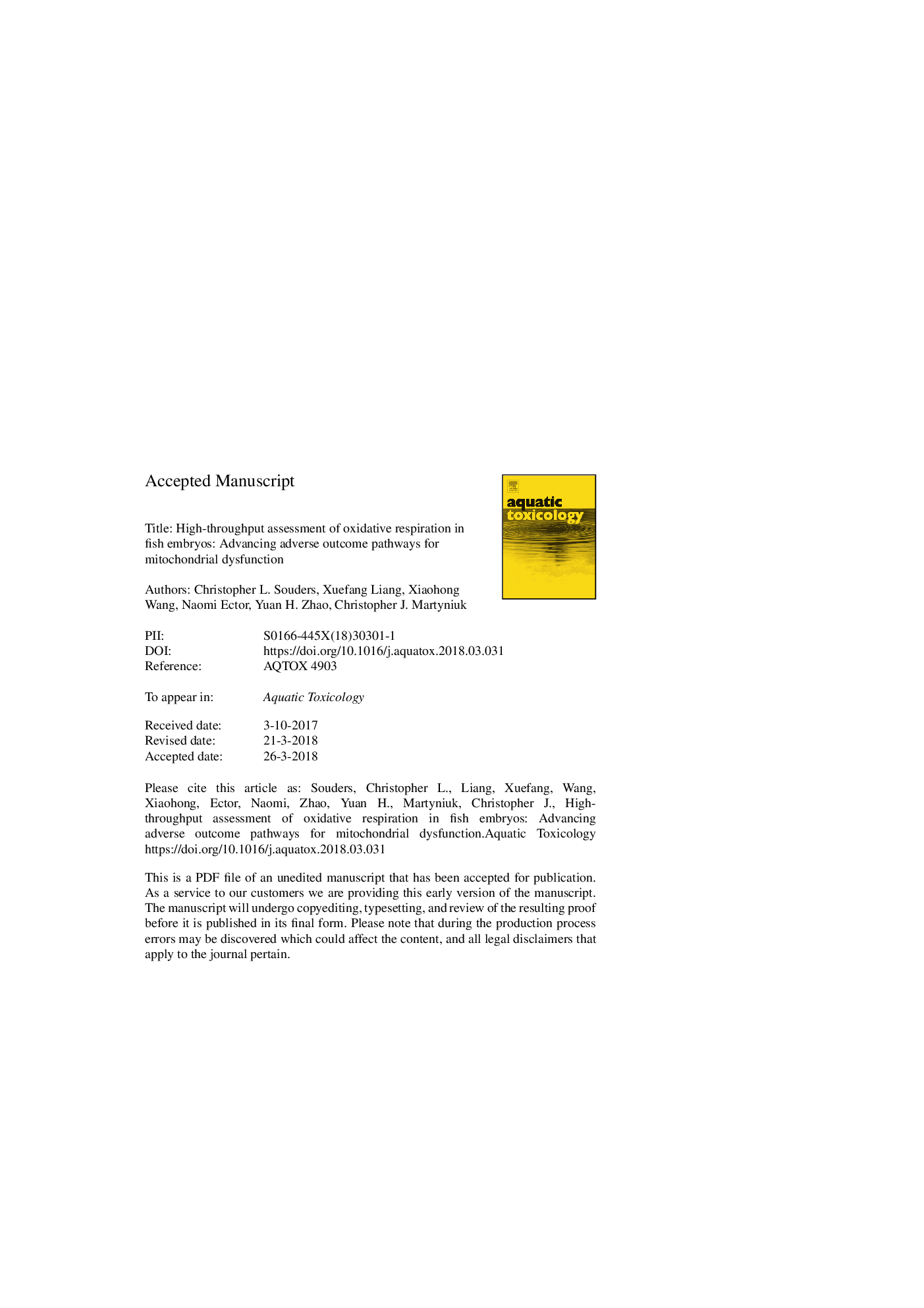| کد مقاله | کد نشریه | سال انتشار | مقاله انگلیسی | نسخه تمام متن |
|---|---|---|---|---|
| 8883728 | 1625906 | 2018 | 44 صفحه PDF | دانلود رایگان |
عنوان انگلیسی مقاله ISI
High-throughput assessment of oxidative respiration in fish embryos: Advancing adverse outcome pathways for mitochondrial dysfunction
ترجمه فارسی عنوان
ارزیابی شدت عملکرد تنفس اکسیداتیو در جنین های ماهی: پیشرفت مسیرهای نامطلوب برای اختلال عملکرد
دانلود مقاله + سفارش ترجمه
دانلود مقاله ISI انگلیسی
رایگان برای ایرانیان
کلمات کلیدی
موضوعات مرتبط
علوم زیستی و بیوفناوری
علوم کشاورزی و بیولوژیک
علوم آبزیان
چکیده انگلیسی
Mitochondrial dysfunction is a prevalent molecular event that can result in multiple adverse outcomes. Recently, a novel high throughput method to assess metabolic capacity in fish embryos following exposure to chemicals has been adapted for environmental toxicology. Assessments of oxygen consumption rates using the Seahorse XF(e) 24/96 Extracellular Flux Analyzer (Agilent Technologies) can be used to garner insight into toxicant effects at early stages of development. Here we synthesize the current state of the science using high throughput metabolic profiling in zebrafish embryos, and present considerations for those wishing to adopt high throughput methods for mitochondrial bioenergetics into their research. Chemicals that have been investigated in zebrafish using this metabolic platform include herbicides (e.g. paraquat, diquat), industrial compounds (e.g. benzo-[a]-pyrene, tributyltin), natural products (e.g. quercetin), and anti-bacterial chemicals (i.e. triclosan). Some of these chemicals inhibit mitochondrial endpoints in the μM-mM range, and reduce basal respiration, maximum respiration, and spare capacity. We present a theoretical framework for how one can use mitochondrial performance data in zebrafish to categorize chemicals of concern and prioritize mitochondrial toxicants. Noteworthy is that our studies demonstrate that there can be considerable variation in basal respiration of untreated zebrafish embryos due to clutch-specific effects as well as individual variability, and basal oxygen consumption rates (OCR) can vary on average between 100 and 300â¯pmol/min/embryo. We also compare OCR between chorionated and dechorionated embryos, as both models are employed to test chemicals. After 24â¯h, dechorionated embryos remain responsive to mitochondrial toxicants, although they show a blunted response to the uncoupling agent carbonylcyanide-4-trifluoromethoxyphenylhydrazone (FCCP); dechorionated embryos are therefore a viable option for investigations into mitochondrial bioenergetics. We present an adverse outcome pathway framework that incorporates endpoints related to mitochondrial bioenergetics. High throughput bioenergetics assays conducted using whole embryos are expected to support adverse outcome pathways for mitochondrial dysfunction.
ناشر
Database: Elsevier - ScienceDirect (ساینس دایرکت)
Journal: Aquatic Toxicology - Volume 199, June 2018, Pages 162-173
Journal: Aquatic Toxicology - Volume 199, June 2018, Pages 162-173
نویسندگان
Christopher L. 2nd, Xuefang Liang, Xiaohong Wang, Naomi Ector, Yuan H. Zhao, Christopher J. Martyniuk,
